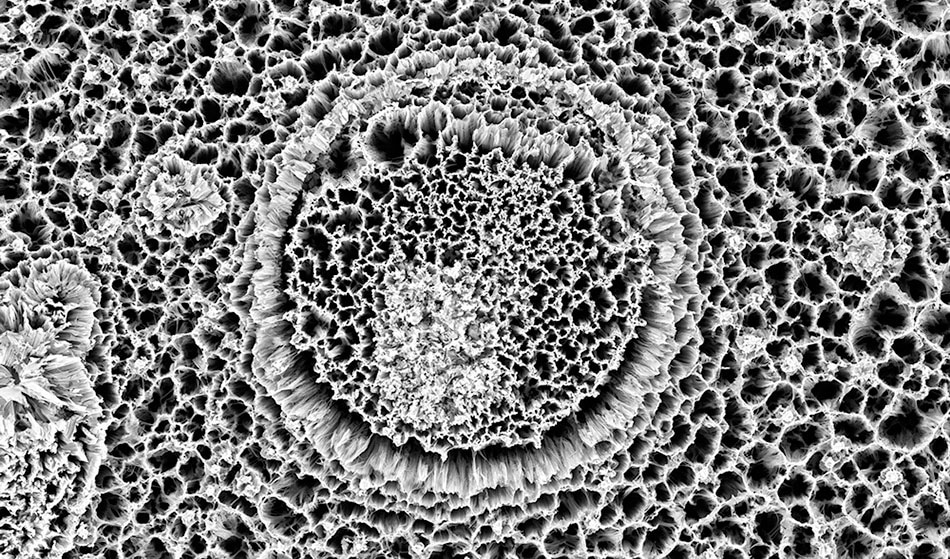Silicon nanowires have become a well-documented and researched material. They possess semiconducting properties, namely a low thermal conductivity, which is a useful trait for thermoelectric devices. Despite already having low thermal conductivity, a team of researchers from Japan has attempted to reduce it further by employing “wings” to silicon nanowires and create a structure which is known as silicon fishbone nanowires.
 Silicon nanowires observed with an electron microscope. (Image credit: Roberto Lo Savio/Shutterstock)
Silicon nanowires observed with an electron microscope. (Image credit: Roberto Lo Savio/Shutterstock)
The ability to produce a nanomaterial with a low thermal transport has gathered a lot of attention recently, particularly within semiconducting nanowires. Semiconducting nanowires that possess these properties can be used as the fundamental building blocks for larger thermoelectric devices, and the optimization of the thermal properties is something being pursued by researchers. Use of these thermoelectric devices is thought to be set for thermoelectric energy generation, even at cryogenic temperatures.
For such devices to be realized, semiconducting nanowires, and in particular, those made of silicon, have gathered a lot of attention and study as the principal units. One main reason is that these nanowires possess the ability to suppress heat conduction at their surface by diffuse scattering any phonons that encounter them. Researchers have previously suggested that this scattering could be increased, and subsequently, the thermal conductivity reduced, by incorporating extra restrictions to the nanowires. Theoretical calculations suggested that using wings or pillars show the most promise.
Now, a team of researchers from multiple institutions in Japan have employed a dual experimental-theoretical approach to create silicon fishbone nanowires (silicon nanowires with specifically placed periodic wings), in an attempt to create a nanowire with an even smaller thermal conductivity and properties that bridge both nanowires and photonic materials.
The researchers created the fishbone nanowires using electron beam lithography (EBL) and inductively coupled plasma reactive-ion etching (ICP-RIE, Oxford instruments PlasmaLab 100), onto the (100) surface plane of a silicon-on-insulator (SOI) wafer. The lithography beam was used to ‘draw’ the desired fishbone structure, and the actual deposition of silicon was performed by the ICP-RIE instrument.
The researchers categorized the structure using scanning electron microscopy (SEM) and measured the thermal properties using a micro time domain thermoreflectance (µ-TDTR) technique. The researchers also complimented the experimental measurements with phonon transport simulations by using ALAMODE and Quantum Espresso packages to measure the anharmonic lattice dynamics and the interatomic force constants of the silicon, respectively.
The researchers undertook the experiments under room temperature conditions and measured the thermal conductivity at different structural points along the nanowires. The individual structural parameters of neck size, wing depth, and wing width were all taken into consideration.
The researchers found similarities between pristine and fishbone nanowires, in that the cross-section controls the thermal conductivity of the nanowire. However, it was found that the wings aid in reducing the thermal conductivity of the nanowire and was found to be lower than a nanowire without the wings.
The main cause of the reduction of thermal conductivity has been attributed to the wing depth. While the wing width does affect the thermal conductivity, it is not by much. In comparison, the wing depth causes a reduction in the thermal conductivity, and this was shown to be stronger in narrower nanowires- i.e., when the central neck part is thinner.
The reduction in thermal conductivity as a function of wing depth has been attributed to the trapping and backscattering of photons in the wings. Overall, the thermal conductivity and thermal relaxation rates of the fishbone nanowires can be reduced by 20% and 35%, respectively, compared to pristine nanowires at room temperature.
The researchers also found that the fishbone nanowires possess an additional degree of freedom in heat conduction compared to pristine nanowires. As the neck volume remains constant, even though the total volume increases from the wings, there is no reduction in electrical conductivity against pristine nanowires. The combination of thermal and electric properties, therefore, makes these fishbone nanowires a promising candidate in thermoelectric applications.
Disclaimer: The views expressed here are those of the author expressed in their private capacity and do not necessarily represent the views of AZoM.com Limited T/A AZoNetwork the owner and operator of this website. This disclaimer forms part of the Terms and conditions of use of this website.
Source:
“Thermal conductivity reduction in silicon fishbone nanowires”- Maire J., et al, Scientific Reports, 2018, DOI:10.1038/s41598-018-22509-0